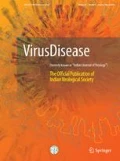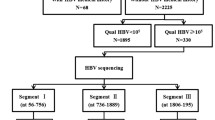Abstract
Evolution of hepatitis B virus (HBV) is a mystery and caused mainly by genomic mutations as well as recombination. Viral evolution may be responsible for increasing disease severity and render resistance to the existing treatment processes. HBV/C2 strain is associated with chronicity, which may progress to the liver cirrhosis and hepatocellular carcinoma. Furthermore, HBV/C2 strain is highly prevalent in the chronic hepatitis B patients in Bangladesh. Hence, the molecular evolution of that strain and its disease pattern need to be uncovered. Herein, the purpose of this study is to determine the potential mutations of HBV complete genome sequences isolated in Bangladesh and the molecular evolution of HBV/C2 strain. Mutation analysis of the total 57 complete genome sequences of HBV in Bangladesh revealed that 42.11%, 12.28%, 7.02% and 3.51% of the strains were vaccine resistant, HBsAg detection escape, HBV immunoglobulin escape, multi-drug resistant respectively. Furthermore, of the vaccine resistant strains, 16.67% were observed resistant to both vaccine, HBsAg detection and immunoglobulin escape. Bayesian skyline analysis with 462 HBV/C2 strains from 2000 to 2017 revealed the evolution of the strain was in nineteenth century with two rapid sharp increases in the genetic diversity at the end of the twentieth century and then a sudden decrease in the early twenty-first century as observed in C and X gene analysis. This study may help researchers and clinicians to get a better knowledge about the emergence and evolution of HBV/C2 strain that may help to find a proper treatment strategy against hepatitis B.


Similar content being viewed by others
References
Allen AM, Irwin GR, Karwacki JJ, Warren DC, Levine RS. Epidemic hepatitis B: a sustained outbreak in a large military population. Am J Epidemiol. 1975;102(6):545–52.
Bouckaert R, Heled J, Kühnert D, Vaughan T, Wu C-H, Xie D, et al. BEAST 2: a software platform for bayesian evolutionary analysis. PLoS Comput Biol. 2014;10(4):e1003537. https://doi.org/10.1371/journal.pcbi.1003537.
de Man RA, Bartholomeusz AI, Niesters HG, Zondervan PE, Locarnini SA. The sequential occurrence of viral mutations in a liver transplant recipient re-infected with hepatitis B: hepatitis B immune globulin escape, famciclovir non-response, followed by Lamivudine resistance resulting in graft loss. J Hepatol. 1998;29(4):669–75.
Dos Santos M, Pacheco SR, Stocker A, Schinoni MI, Parana R, Reis MG, et al. Mutations associated with drug resistance and prevalence of vaccine escape mutations in patients with chronic hepatitis B infection. J Med Virol. 2017;89(10):1811–6. https://doi.org/10.1002/jmv.24853.
Gerlich WH. Medical virology of hepatitis B: how it began and where we are now. Virol J. 2013;10:239. https://doi.org/10.1186/1743-422x-10-239.
Hossain MG, Ueda K. Investigation of a novel hepatitis B virus surface antigen (HBsAg) escape mutant affecting immunogenicity. PLoS ONE. 2017;12(1):e0167871. https://doi.org/10.1371/journal.pone.0167871.
Lin YY, Liu C, Chien WH, Wu LL, Tao Y, Wu D, et al. New insights into the evolutionary rate of hepatitis B virus at different biological scales. J Virol. 2015;89(7):3512–22. https://doi.org/10.1128/JVI.03131-14.
Littlejohn M, Locarnini S, Yuen L. Origins and evolution of hepatitis B virus and hepatitis D virus. Cold Spring Harbor Perspect Med. 2016;6(1):a021360. https://doi.org/10.1101/cshperspect.a021360.
McAleer WJ, Buynak EB, Maigetter RZ, Wampler DE, Miller WJ, Hilleman MR. Human hepatitis B vaccine from recombinant yeast. Nature. 1984;307(5947):178–80.
Munshi SU, Tran TTT, Vo TNT, Tabassum S, Sultana N, Nguyen TH, et al. Molecular characterization of hepatitis B virus in Bangladesh reveals a highly recombinant population. PLoS ONE. 2017;12(12):e0188944. https://doi.org/10.1371/journal.pone.0188944.
Osiowy C, Giles E, Tanaka Y, Mizokami M, Minuk GY. Molecular evolution of hepatitis B virus over 25 years. J Virol. 2006;80(21):10307–14. https://doi.org/10.1128/JVI.00996-06.
Ramezani F, Norouzi M, Sarizade GR, Poortahmasebi V, Kalantar E, Magnius L, et al. Mutation hot spots in hepatitis B surface antigen in chronic carriers from Khoozestan province, southern of Iran. Iran J Allergy Asthma Immunol. 2013;12(3):269–75.
Shaha M, Hoque SA, Ahmed MF, Rahman SR. Effects of risk factors on anti-HBs development in hepatitis B vaccinated and nonvaccinated populations. Viral Immunol. 2015;28(4):217–21. https://doi.org/10.1089/vim.2014.0147.
Shaha M, Hoque SA, Rahman SR. Molecular epidemiology of hepatitis B virus isolated from Bangladesh. Springerplus. 2016;5(1):1513. https://doi.org/10.1186/s40064-016-3174-5.
Shaha M, Das KC, Hossain MS, Jahan M, Hashem A, Rahman SR, et al. Complete genome sequence of a circulating hepatitis B virus genotype C strain isolated from a chronically infected patient identified at an outdoor hospital in Bangladesh. Genome Announc. 2018. https://doi.org/10.1128/genomea.01601-17.
Shaha M, Hadisur Rahman M, Jahan M, Dey SK, Das KC, Hashem A, et al. Identification of a novel tri-genotypic recombinant hepatitis B virus in Bangladesh. Virus Res. 2018. https://doi.org/10.1016/j.virusres.2018.07.014.
Shaha M, Sarker PK, Hossain MS, Das KC, Jahan M, Dey SK, et al. Analysis of the complete genome of hepatitis B virus subgenotype C2 isolate NHB17965 from a HBV infected patient. F1000Research. 2018;7:1023. https://doi.org/10.12688/f1000research.15090.3.
Simmonds P. Reconstructing the origins of human hepatitis viruses. Philos Trans R Soc B Biol Sci. 2001;356(1411):1013–26. https://doi.org/10.1098/rstb.2001.0890.
Tamura K, Stecher G, Peterson D, Filipski A, Kumar S. MEGA6: molecular evolutionary genetics analysis version 6.0. Mol Biol Evol. 2013;30(12):2725–9. https://doi.org/10.1093/molbev/mst197.
Zhang HW, Yin JH, Li YT, Li CZ, Ren H, Gu CY, et al. Risk factors for acute hepatitis B and its progression to chronic hepatitis in Shanghai, China. Gut. 2008;57(12):1713–20. https://doi.org/10.1136/gut.2008.157149.
Acknowledgements
The study was supported by the National Institute of Biotechnology, Ministry of Science and Technology, Bangladesh.
Author information
Authors and Affiliations
Corresponding author
Ethics declarations
Conflict of interest
The authors declare that there is no any conflict of interest.
Electronic supplementary material
Below is the link to the electronic supplementary material.
Rights and permissions
About this article
Cite this article
Shaha, M., Chakraborty, S., Hossain, M.S. et al. Molecular evolution and genomics of hepatitis B virus subgenotype C2 strain predominant in the chronic patients in Bangladesh. VirusDis. 29, 486–490 (2018). https://doi.org/10.1007/s13337-018-0497-6
Received:
Accepted:
Published:
Issue Date:
DOI: https://doi.org/10.1007/s13337-018-0497-6




